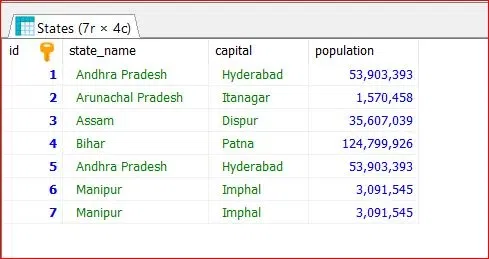How to Delete Duplicate Rows in MariaDB
Last Updated :
12 Mar, 2024
Duplicate rows in a database can lead to data inconsistencies and inefficiencies. In MariaDB, we can remove duplicate rows using various methods to ensure data integrity and optimize database performance.
In this article, We will explore different techniques to identify and delete duplicate rows in MariaDB with the help of examples and so on.
How to Delete Duplicate Rows in MariaDB
Duplicate rows in a database can lead to data inconsistencies and inefficiencies, impacting database performance and integrity. MariaDB provides several methods to identify and delete duplicate rows. Below are the methods that help us to delete duplicate rows in MariaDB are as follows:
- Using DELETE Statement
- Using Subquery
- Using Temporary Table
Let’s set up an environment
To understand How to delete duplicate rows in MariaDB we need a table on which we will perform various operations and queries. Here we will consider a table called indian_states which contains id, state_name, capital, and population as Columns.
We can see our table has been created successfully.

States Table
Identify Duplicate Rows
Identify the duplicate rows in our table by executing the below steps:
Using GROUP BY and HAVING Clause: Construct a query grouping by the columns which define uniqueness and filter using the HAVING clause to identify rows having a count greater than one.
SELECT state_name, capital, COUNT(*) FROM States GROUP BY state_name, capital HAVING COUNT(*) > 1;
This query will group the records by state_name and capital, and then it will count the number of occurrences for each group. Finally, it will only return the groups where the count is greater than 1, indicating duplicate entries based on the combination of state_name and capital.
Output:

Duplicate rows
Explanation: As we can see that there are two duplicate rows in our table.
1. Using DELETE Statement
After identifying duplicate rows, remove them using the DELETE statement. Ensure you have a backup before executing the delete operation.
DELETE FROM indian_states
WHERE id NOT IN (
SELECT MIN(id)
FROM indian_states
GROUP BY state_name, capital
);
Output:

Duplicates Removed
Explanation: This query selects the minimum id for each unique combination of state_name and capital, and then deletes all rows from the indian_states table where the id is not the minimum id for that combination. As we can see that there are no duplicates in our table.
This effectively keeps only one instance of each unique combination and removes duplicates.
2. Using Subquery
We’ll assume that the table has been restored to its original state (with the duplicates).
DELETE FROM States
WHERE (state_name, capital, id) NOT IN (
SELECT state_name, capital, MIN(id)
FROM States
GROUP BY state_name, capital
);
Output:

Duplicates Removed
Explanation: This query deletes rows from the States table where the combination of state_name and capital is not associated with the minimum id value for each combination. This effectively retains only one instance of each unique combination and removes duplicates. Now there are no duplicates in our States table.
3. Using Temporary Table
We’ll assume that the table has been restored to its original state (with the duplicates).
Create a temporary table with distinct records and then overwrite the original table with the temporary one.
-- Create a temporary table with distinct rows
CREATE TABLE temp_states AS SELECT DISTINCT * FROM states;
-- Drop the original states table
DROP TABLE states;
-- Rename the temporary table to replace the original states table
ALTER TABLE temp_states RENAME TO states;
Output:

Duplicates Removed
Explanation:
- CREATE TABLE temp_table AS SELECT DISTINCT * FROM states;: This statement creates a new table temp_table with the distinct rows from the states table. All columns and their data types will be copied from the original states table.
- DROP TABLE states;: This statement removes the original states table from the database. All data and table structure will be permanently deleted.
- ALTER TABLE temp_table RENAME TO states;: This statement renames the newly created temp_table to states, effectively replacing the original table with the deduplicated data.
- After executing these SQL statements, the states table will contain only distinct rows, and the original table will be replaced. Only unique values are there.
Conclusion
Overall, It is very important to choose a good strategy for automatic removal of the overlapping rows in a MariaDB database as it will ensure that the data integrity of the system stays on a high level and its performance is optimized. with the implementation of the specified tools, administrators can correctly identify, delete, and prevent replicated entries thus can maintain a uncomplicated database. You should always be aware of the dangers that might arise if you lose your data and try creating backups beforehand to ensure that in case of any accidental loss of data, you do not lose it completely.
Share your thoughts in the comments
Please Login to comment...